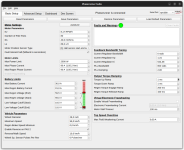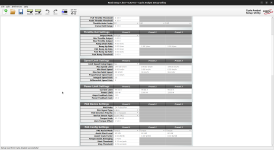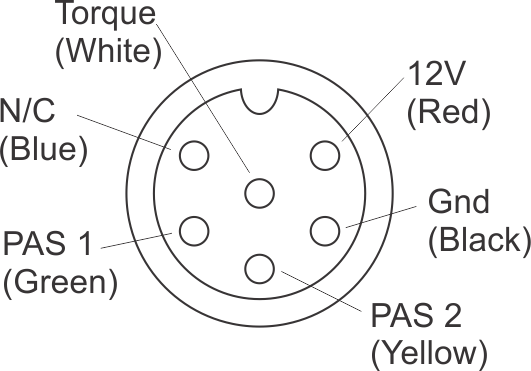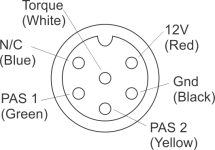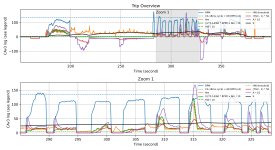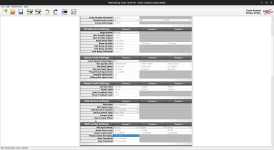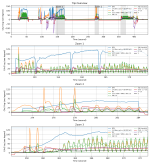Hi,
I have been running a GMAC + Phaserunner + Cycle Analyst (all 3 from Grin) + Sempu T2 torque sensor (Aliexpress) for a few years now and while the overall performance is generally good, I have been frustated with the torque assist. The main issue is a delayed response of the motor after a pause in pedalling, with an overshoot of about 2x the "steady" assist. Note the CA is not 100% compatible with the Sempu since the latter has 48 poles and the CA v3.15 only allows up to 32 poles in the setup, but I was told this only affects the Human Watts reading. Anyway, I finally found the time to investigate what's going on in more details, and I'm hoping to get feedbacks for improvement here.
I used the Grin programming cable to log the CA data onto my laptop . What I found is that there is 1) a tendency of the torque signal to overshoot (sensor only or sensor-CA communication?) 2) a small lag between torque sensing and the generated throttle output (from the CA perspective), but probably more determining is 3) a longer lag between throttle output (or input into the controller) and the ampere reading. Now the graphs make me thing the apparently long lag may be partly an issue in the logging of the Ampere signal, but I might nevertheless have the finger on something. Anyone has knowledge or experience with the response time of the Phaserunner controller to the throttle signal?
MORE DETAILS BELOW
I attached my Phaserunner and CA settings (corresponding to the last run). Note I reduced the throttle ramp up signal to 1 ms.
The log data should be 10 Hz, so every 10 steps in the attached graph correspond to 1 second. There are 14 different channels logged out from the CA, but for the sake of usefulness and readability I plotted only RPM (pedal cadence in round per minute, blue, scaled by 1/5), the torque in Nm (orange, scaled by 1/2), the human power as calculated from the previous two (green, scaled by 1/10), the throttle output sent out by the CA to the Phaserunner (red, centered to be zero at rest and scaled by 30), the current in Ampere (drawn from the battery?) (purple, scaled by 10), and the bike Speed (black). The scaling only serves to have it all on the same axes. I used my own calculation for Human watt (essentially RPM * torque) because the Human Watt signal from the CA was significantly lagged, not sure why. Anyway, the most important things are 1) the torque * RPM sigmal received by the CA (green), the throttle output it makes from it (red), and the battery ampere as a result (purple).
I share an overview of 4 "runs" (cut outs to show the same horizontal scale):
1. Pedal torque only. CA averaging over 24 poles, 200 ms Torque Ramp in the phaserunner
2. Pedal torque only. No CA averaging, 200 ms Torque Ramp in the phaserunner
3. Pedal torque only. No CA averaging, 1 ms Torque Ramp in the phaserunner
4. Throttle input then pedal torque. No CA averaging, 1 ms Torque Ramp in the phaserunner
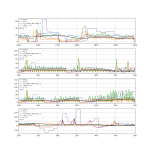
and then a zoon on the latest run with:
1. overview
2. input only
3. throttle only
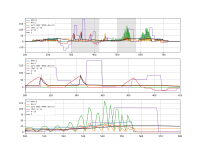
From the many things one can see from these graphs, I'd like to draw your attention on the following:
- (First Figure): There tend to be a peak in the torque, generally after a break in pedalling (after the blue curve gets to something greater than 0), though it sometimes happens a little later. It might be a true signal, but it suspect it is exxagerated / an amplificatoin. That is likely related to the sensor itself (or how it communicated with the CA)
- (All Figure) there is a small lag, and in any case no 1:1 correspondance, between the RPM*torque signal and the CA throttle output response, which cannot be explained by the ramp-up limit of 4V/sec (the first run had a slower ramp up, but the lag can be observed even in the latest experiments).
- (First Figure): the torque signal shown (orange and green) is after the averaging (the oscillations get much larger from the second panel, after removing CA averaging).
- (All figures): there is an apparent lag of about 10 steps (~1 second) between the throttle input and ampere reading, which I interprete as a lag in the phaserunner.
- (Second figure, second panel): in the second of three throttle only input, I see the speed increases before 5 steps (500ms) before the ampere reading, which suggests an error in the reading. However, the speed signal is obserbed about 10 steps (1 sec) after the throttle signal. Note the throttle rises as a triangle because it is limited to about 2V/second ramp up -- this corresponds to the up slop after correcting for the *30 scaling factor.
When used with the throttle, the lag does not matter much, but it is frustrating when used from torque assist, where you'd expect a much more direct response to the pedalling (especially with such a sensor like the Sempu with many poles). This is especially frustrating when it combines with the torque peak after a pedalling break, leading to a delayed overshoot. In the course of these experiments, removing the CA averaging did improve the felt responsiveness, but removing the 200ms throttle ramp up in the Phaserunner did not.
I feel for improved diagnostic I'd need a more accurate reading of the battery current draw in response to the throttle output from CA, but I'm not sure how best to do this.
Thanks to anyone reading to this point.
Looking forward to feedbacks to understand and improve the issue I am experiencing.
Mahé
I have been running a GMAC + Phaserunner + Cycle Analyst (all 3 from Grin) + Sempu T2 torque sensor (Aliexpress) for a few years now and while the overall performance is generally good, I have been frustated with the torque assist. The main issue is a delayed response of the motor after a pause in pedalling, with an overshoot of about 2x the "steady" assist. Note the CA is not 100% compatible with the Sempu since the latter has 48 poles and the CA v3.15 only allows up to 32 poles in the setup, but I was told this only affects the Human Watts reading. Anyway, I finally found the time to investigate what's going on in more details, and I'm hoping to get feedbacks for improvement here.
I used the Grin programming cable to log the CA data onto my laptop . What I found is that there is 1) a tendency of the torque signal to overshoot (sensor only or sensor-CA communication?) 2) a small lag between torque sensing and the generated throttle output (from the CA perspective), but probably more determining is 3) a longer lag between throttle output (or input into the controller) and the ampere reading. Now the graphs make me thing the apparently long lag may be partly an issue in the logging of the Ampere signal, but I might nevertheless have the finger on something. Anyone has knowledge or experience with the response time of the Phaserunner controller to the throttle signal?
MORE DETAILS BELOW
I attached my Phaserunner and CA settings (corresponding to the last run). Note I reduced the throttle ramp up signal to 1 ms.
The log data should be 10 Hz, so every 10 steps in the attached graph correspond to 1 second. There are 14 different channels logged out from the CA, but for the sake of usefulness and readability I plotted only RPM (pedal cadence in round per minute, blue, scaled by 1/5), the torque in Nm (orange, scaled by 1/2), the human power as calculated from the previous two (green, scaled by 1/10), the throttle output sent out by the CA to the Phaserunner (red, centered to be zero at rest and scaled by 30), the current in Ampere (drawn from the battery?) (purple, scaled by 10), and the bike Speed (black). The scaling only serves to have it all on the same axes. I used my own calculation for Human watt (essentially RPM * torque) because the Human Watt signal from the CA was significantly lagged, not sure why. Anyway, the most important things are 1) the torque * RPM sigmal received by the CA (green), the throttle output it makes from it (red), and the battery ampere as a result (purple).
I share an overview of 4 "runs" (cut outs to show the same horizontal scale):
1. Pedal torque only. CA averaging over 24 poles, 200 ms Torque Ramp in the phaserunner
2. Pedal torque only. No CA averaging, 200 ms Torque Ramp in the phaserunner
3. Pedal torque only. No CA averaging, 1 ms Torque Ramp in the phaserunner
4. Throttle input then pedal torque. No CA averaging, 1 ms Torque Ramp in the phaserunner

and then a zoon on the latest run with:
1. overview
2. input only
3. throttle only

From the many things one can see from these graphs, I'd like to draw your attention on the following:
- (First Figure): There tend to be a peak in the torque, generally after a break in pedalling (after the blue curve gets to something greater than 0), though it sometimes happens a little later. It might be a true signal, but it suspect it is exxagerated / an amplificatoin. That is likely related to the sensor itself (or how it communicated with the CA)
- (All Figure) there is a small lag, and in any case no 1:1 correspondance, between the RPM*torque signal and the CA throttle output response, which cannot be explained by the ramp-up limit of 4V/sec (the first run had a slower ramp up, but the lag can be observed even in the latest experiments).
- (First Figure): the torque signal shown (orange and green) is after the averaging (the oscillations get much larger from the second panel, after removing CA averaging).
- (All figures): there is an apparent lag of about 10 steps (~1 second) between the throttle input and ampere reading, which I interprete as a lag in the phaserunner.
- (Second figure, second panel): in the second of three throttle only input, I see the speed increases before 5 steps (500ms) before the ampere reading, which suggests an error in the reading. However, the speed signal is obserbed about 10 steps (1 sec) after the throttle signal. Note the throttle rises as a triangle because it is limited to about 2V/second ramp up -- this corresponds to the up slop after correcting for the *30 scaling factor.
When used with the throttle, the lag does not matter much, but it is frustrating when used from torque assist, where you'd expect a much more direct response to the pedalling (especially with such a sensor like the Sempu with many poles). This is especially frustrating when it combines with the torque peak after a pedalling break, leading to a delayed overshoot. In the course of these experiments, removing the CA averaging did improve the felt responsiveness, but removing the 200ms throttle ramp up in the Phaserunner did not.
I feel for improved diagnostic I'd need a more accurate reading of the battery current draw in response to the throttle output from CA, but I'm not sure how best to do this.
Thanks to anyone reading to this point.
Looking forward to feedbacks to understand and improve the issue I am experiencing.
Mahé


